The Seventh TRIZ Symposium in Japan, Held by Japan TRIZ Society on Sept. 8-10, 2011 at Toshiba Kenshu Center, Yokohama, Japan
ETRIA TRIZ Future Conference 2011, Held on Nov. 2-4, 2011, at Institute of Technology Tallaght, Dublin, Ireland
| Problem Solving in Everyday Life: On Methods and Tools for Weeding (or Removing Weeds) | |
| Takahisa Miyke, Toru Nakagawa (Osaka Gakuin Univ.) | |
|
|
| Toru Nakagawa, Takahisa Miyke (Osaka Gakuin Univ.) | |
ETRIA TRIZ Future Conference 2011, Held on Nov. 2-4, 2011, at Institute of Technology Tallaght, Dublin, Ireland |
|
| [Posted on Nov. 18, 2011] |
For going back to Japanese pages, press buttons.
Editor's Note (Toru Nakagawa, Nov. 18, 2011)
This paper is based on the Thesis work by Takahisa Miyake at Nakagawa's Seminar in Faculty of Informatics, Osaka Gakuin University. As shown above, the paper was presented by Nakagawa at the 7th Japan TRIZ Symposium in a Poster Session last September (in Japanese and in English). Then it was presented as a Short Paper at ETRIA TFC2011 in Dublin, Ireland, two weeks ago.
Thus in this site, the paper is posted in the English page mostly in the form of ETRIA TFC presentation, while in the Japanese page mostly in the form of Japan TRIZ Symposium presentation. For the purpose of readers' convenience, I show them in two formats: i.e., the HTML & slide image format (for easier access) and the PDF format (for better readability). .
Weeding, or removing weeds, is a labor work experienced since ancient days and by almost everybody. Huge variety of tools (and some machines) have been developed. Thus, if one chooses a method of removing weeds and tries to improve it, one may think it a small problem (without mentioning whether one can really find a new useful solution). However, we notice a diversity of requirements for 'removing weeds', in the aspects of purposes, goals of finishing, sorts and situations of weeds, distributions of weeds and crops, etc., which request different method and tools. For the international audience of ETRIA TFC, the situations in their home countries can be much different from the ones in Japan, especially in climate, culture and usage of lands, sorts and growing speed of weeds, etc. Thus the evaluation of each method or tool may be different. Considering such differences, we try to understand the problem of removing weeds in a wide perspective, including the purposes, goals of finishing, methods (their intentions and mechanisms), tools (and their variations), effectiveness, etc., and to find/evaluate effective methods and tools/
In other words, 'how to understand the problem' is the main theme of the present paper in the aspect of research methodology. For TRIZ, as a creative problem solving methodology, the approach to understand a problem in a systematic manner is certainly necessary before trying to find solutions to the problem. The framework of the present work may be a typical procedure in engineering design, and may be not new. I believe, however, this work presents a useful case study for demonstrating the desirable approach to understanding a vaguely defined problem, regardless of using TRIZ or not. [I am now trying to improve the method/tool which is highly recommended here, but need some more time to find an useful solution yet.]
| Top of this page | Abstract & Short Paper | Short Paper in PDF |
Slides | Slides ( PDF) |
Slides in Japanese |
Japan TRIZ Symp. 2011 |
Japanese page |
[1] Abstract & Short Paper
Problem Solving in Everyday Life:
On Methods and Tools for Weeding (or Removing Weeds)Toru Nakagawa and Takahisa Miyake
(Osaka Gakuin University, Japan)ETRIA TRIZ Future Conference 2011
Held on Nov. 2-4, 2011, at Institute of Technology Tallaght, Dublin, IrelandAbstract
"Weeding" (or removing weeds) is a labor work which has been performed since ancient days, and hence a large variety of tools and machines have been developed. However it is still a heavy burden of labor at home, at farms, in parks, in town, etc. How can we reduce the burden of weeding? This problem appears small and simple at first sight, but it is actually big and difficult. The difficulty stems from the fact that the problem situations are quite different (especially depending on the climates and culture in different countries/regions). What is the purpose (i.e., what types of results one wants), at what kind of place/ground, what kinds of weeds/grass are growing, what kinds of useful plants are there, etc. How can we classify the methods of weeding (i.e., cutting/pulling/removing/etc. weeds)? How should we classify the tools? On the basis of consideration from these viewpoints, we have built up the guidelines where in various situations (of purposes, places, types of weeds, etc.) we recommend the types of methods and types of tools/machines to be applied. One of the concluding recommendations is 'cutting the weeds just below the ground surface' rather than 'cutting the weeds above the ground' or 'pulling the weeds out'.
Keywords: defining a problem; purpose-goal-method; method-tool-mechanism; methods of removing weed
1. Introduction and defining the problem of 'Removing weeds'
This paper is based on a thesis work for a Bachelor degree by Miyake, whose family operates a gardening business. The present topic was chosen as a common problem in everyday life.
Even though the problem appears small and simple, it actually extends so widely in quite different situations that we should understand and define the problem within a broader perspective. We realize that we need to view and classify the problem situations from multiple viewpoints, e.g.:
• Purposes: To prepare for planting crops, to remove weeds obstructing the growth of the crops, etc.
• Goals: To remove the obstructing parts of weeds above the ground, to remove/cut the weeds just above the ground, to remove the weeds by the roots, to remove the deep roots as well, etc.
Differences also arise from various usage of the place, different conditions of the ground, different kinds of weeds, variety in extension of roots, different distribution patterns of crops and weeds (See Fig. 1), etc.
[Note: This paper illustrates the importance of problem definition in TRIZ before solving it.]
 |
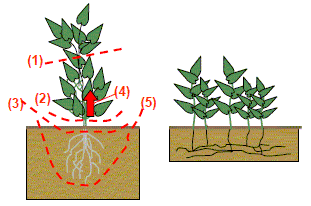 |
|
Fig. 1. Different distributions of crops (stars) and weeds. |
Fig. 2 Where to attack the weeds ? |
2. Methods and tools for removing weeds
Methods for removing weeds can be classified best by the parts of the plant we are going to attack/remove (See Fig. 2): i.e., To remove/cut upper parts of the weeds, to remove/cut/pull the parts of weeds just above the ground, to remove/cut the parts of weeds just below the grounds, to remove the weeds by the root by pulling or digging the ground, to dig in the ground and turn over the whole plant and ground together, etc. A variety of tools have been developed, having different aims in usage, different principles/ mechanisms, and styles of usage.
3. Guidelines for selecting the methods/tools of removing weeds
Based on these considerations, we have chosen to define the problem in the relations of "Purpose - Goal - Method". Then we further classified the current solutions in relations of "Method - Tool - Principle/mechanism - Usage -Evaluation", and the methods evaluated (relatively) highly are summarized in Fig. 3. The present work is a demonstration of how to think of vaguely defined familiar problems.
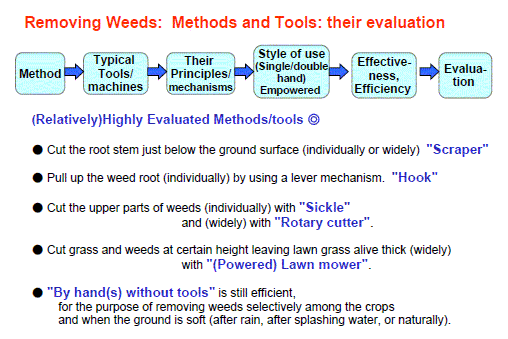
Fig. 3. Methods and tools for removing weeds.
ETRIA TFC2011 Short Paper (in English) PDF

Japan TRIZ Symposium 2011 Extended Abstract (in Japanese) PDF
Miyake's Thesis (Extended Abstract) submitted to Osaka Gakuin Univ. (in Japanese) (Jan. 2011) PDF
[2] Presentation Slides
Slides presented at ETRIA TFC2011
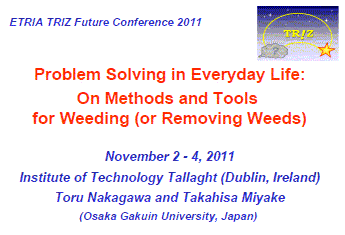
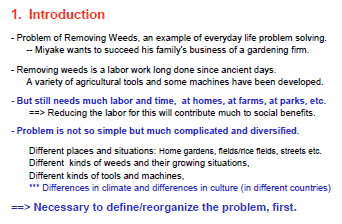
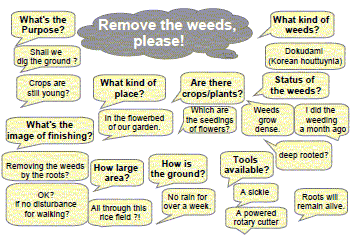
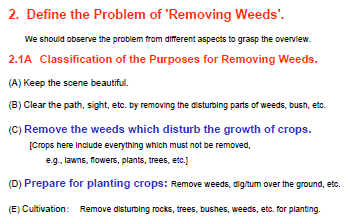
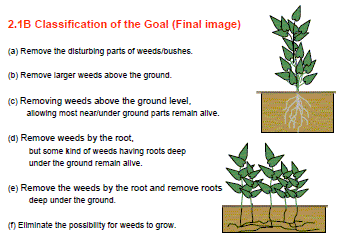
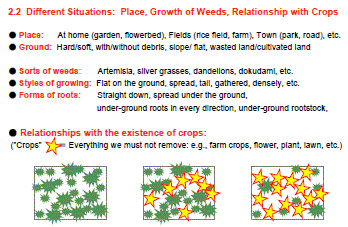
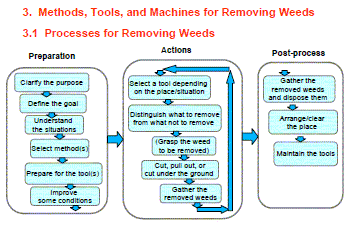
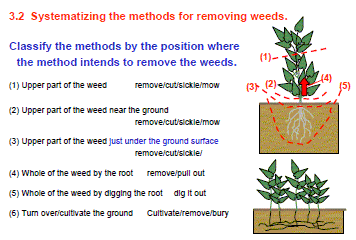
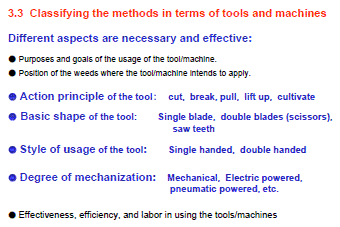
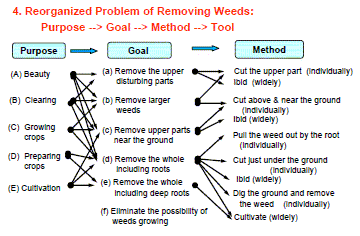
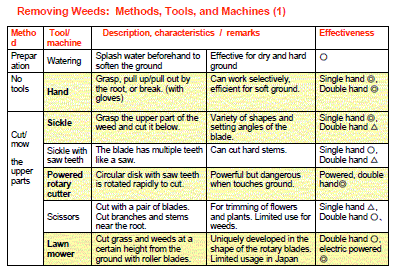 |
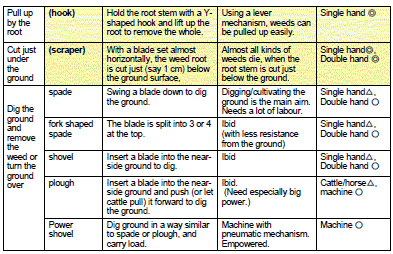  |
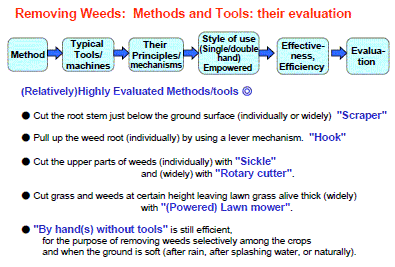
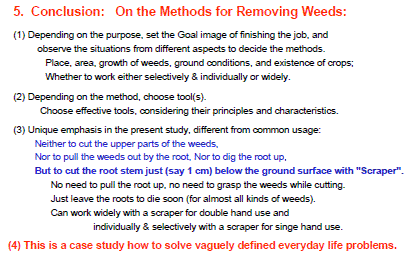
Slides Presented at ETRIA TFC2011 (in English) in PDF

Slides Presented at Japan TRIZ Symposium 2011 (in Japanese) in PDF

| Top of this page | Abstract & Short Paper | Short Paper in PDF |
Slides | Slides ( PDF) |
Slides in Japanese |
Japan TRIZ Symp. 2011 |
Japanese page |
Last updated on Nov. 18, 2011. Access point: Editor: nakagawa@ogu.ac.jp